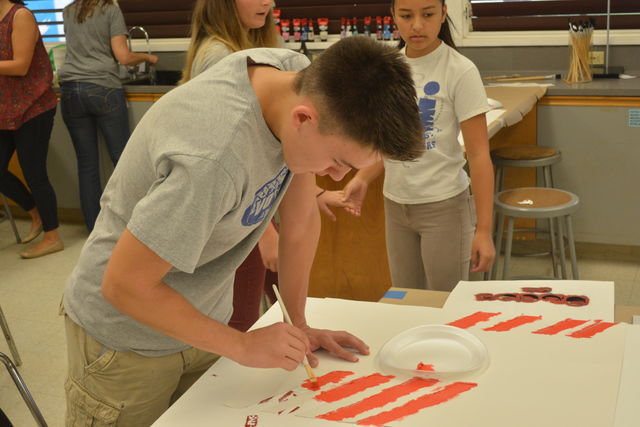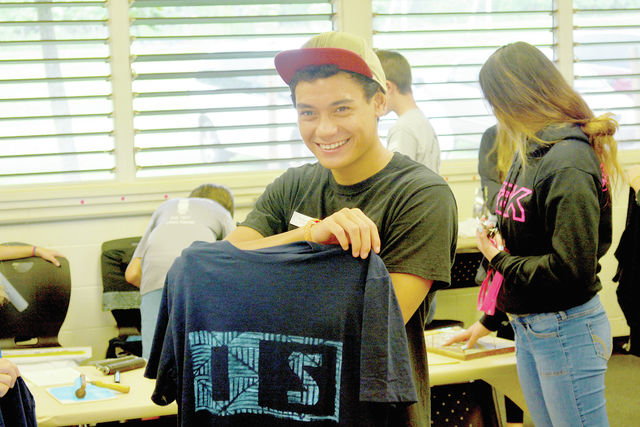PUHI — In one of the art rooms at Island School, each table was lined with paper covering the wood beneath it while the floor was blanketed by a tarp to avoid spills. But giving first- and second-graders access to
PUHI — In one of the art rooms at Island School, each table was lined with paper covering the wood beneath it while the floor was blanketed by a tarp to avoid spills. But giving first- and second-graders access to paints and brushes will always be a messy ordeal.
At Island School’s annual Art Day on Friday, spills and mistakes were encouraged.
“Art is great for children to learn,” said Shannon Morgan. “Just like they are today, kids use art to help them learn how to problem solve. Some kids spilled their paint on their picture where it’s not supposed to go, so they have to get creative to solve that problem. And that also applies into life. Art is a good foundation for kids to draw from.”
Morgan, a teacher at KUGA (Kauai UnderGround Artists) Visual Arts in Kalaheo who volunteered to help out at Art Day, sees art as a way for students to think critically and find solutions on their own in terms that they can understand. Art allows students to think differently, more so than just reading a book or solving mathematical equations, according to Morgan.
Over 400 students from the elementary, intermediate and high school levels participated in the 23 workshops spread out over Island Schools campus.
Painting, stenciling, cooking, improv acting, music, panoramic photography were only a portion of the activities offered on the day which allowed students to interact with each other in a non-formal classroom setting.
Tuba Abbasi, a middle school English teacher at Island School, watched as students painted recycled milk cartons and decorated them into masks.
She said she realized how important it was for the school to use art to bring students together.
“Children don’t often get the opportunity anymore to exercise their creative juices,” Abbasi said. “Art Day provides an opportunity for them to work with different types of mediums and also work with different classmates that they might not ordinarily choose to work with otherwise.”
Art Day is a tradition at Island School and is a tradition that Penny Nichols inherited during the 17 years she’s been teaching art.
“Today is a day when the whole school participates in various types of art,” she said. “I think it’s a lot of fun for the kids but I guess you can say that it forces those students who aren’t that comfortable with the arts to participate.”
Art allows the less-social students to express themselves through non-verbal communication. From drawing to cooking, each student is given an avenue of exploration that they may not have been exposed to before.
“Many times, it’s a revelation for those students,” Nichols said. “There’s some students who are always in those classes and teachers as well, but it gives us all an opportunity to step out from out comfort zones and try something new. That’s really the spirit of the day: to allow yourself to try something that you’ve never done before.”
Some classrooms were transformed into studios and darkrooms for photos to develop while others had hot plates for students to fry eggs and make omelettes.
“It’s kind of a miracle that this event happens,” Nichols said. “This is all done with volunteer labor. We could never really afford to do this, but we live in a community where there is a spirit of volunteerism and we’ve just been kind of amazed every year about how we pull it off.”
It’s an impressive sight to see hundreds of students engaged in a subject without a teacher trying to keep them focused on their work. Most teachers and volunteers watched from a distance as students became self-directed learners, thinking critically while enjoying themselves.
“I think schools should be striving for this all the time,” Nichols said. “It’s not a thrill, I don’t even like the word enrichment. It’s just a proven fact that this art is a unique subject that allows students to think critically and make mistakes. I tell my students in the art room that if you’re not making mistakes, then you’re not doing it right.”




